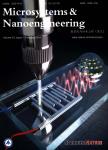Mechanically strengthened graphene-Cu composite with reduced thermal expansion towards interconnect applications
作者机构:Graduate School of EngineeringTohoku UniversityAramaki-Aza-Aoba 6-6-01Aoba-kuSendai 980-8579Japan Research Institute for Engineering and TechnologyTohoku Gakuin UniversityTagajo 985-8537Japan School of Mechanical Engineering and AutomationBeihang UniversityBeijing 100191PR China Department of Mechanical Systems EngineeringTokyo University of Agriculture and TechnologyKoganei 184-8588Japan
出 版 物:《Microsystems & Nanoengineering》 (微系统与纳米工程(英文))
年 卷 期:2019年第5卷第1期
页 面:481-491页
核心收录:
学科分类:08[工学] 0805[工学-材料科学与工程(可授工学、理学学位)] 080502[工学-材料学]
基 金:Part of this study was performed at the Micro/Nanomachining Research Education Center(MNC)and Micro System Integration Center(μSIC)of Tohoku University This research was supported by a Grant-in-Aid from the Japanese Ministry of Education,Culture,Sports,Science and Technology and partly supported by Special Coordination Funds for Promoting Science and Technology and the Formation of Innovation Center for Fusion of Advanced Technologies This study was supported by the Council for Science,Technology and Innovation(CSTI)and Cross-ministerial Strategic Innovation Promotion Program(SIP)
主 题:composite expansion thermal
摘 要:High-density integration technologies with copper(Cu)through-silicon via(TSV)have emerged as viable alternatives for achieving the requisite integration densities for the portable electronics and micro-electro-mechanical systems(MEMSs)***,significant thermo-mechanical stresses can be introduced in integrated structures during the manufacturing process due to mismatches of thermal expansion and the mechanical properties between Cu and silicon(Si).The high-density integration demands an interconnection material with a strong mechanical strength and small thermal expansion *** this study,a novel electroplating method is developed for the synthesis of a graphene-copper(G-Cu)composite with electrochemically exfoliated *** fabrication and evaluation of the G-Cu composite microstructures,including the microcantilevers and micromirrors supported by the composite,are *** evaluated not only the micromechanical properties of the G-Cu composite based on in-situ mechanical resonant frequency measurements using a laser Doppler vibrometer but also the coefficients of thermal expansion(CTE)of the composite based on curvature radius measurements at a temperature range of 20–200℃.The Young’s modulus and shear modulus of the composite are approximately 123 and 51 GPa,which are 1.25 times greater and 1.22 times greater,respectively,than those of pure Cu due to the reinforcement of *** G-Cu composite exhibits a 23%lower CTE than Cu without sacrificing electrical *** results show that the mechanically strengthened G-Cu composite with reduced thermal expansion is an ideal and reliable interconnection material instead of Cu for complex integration structures.



